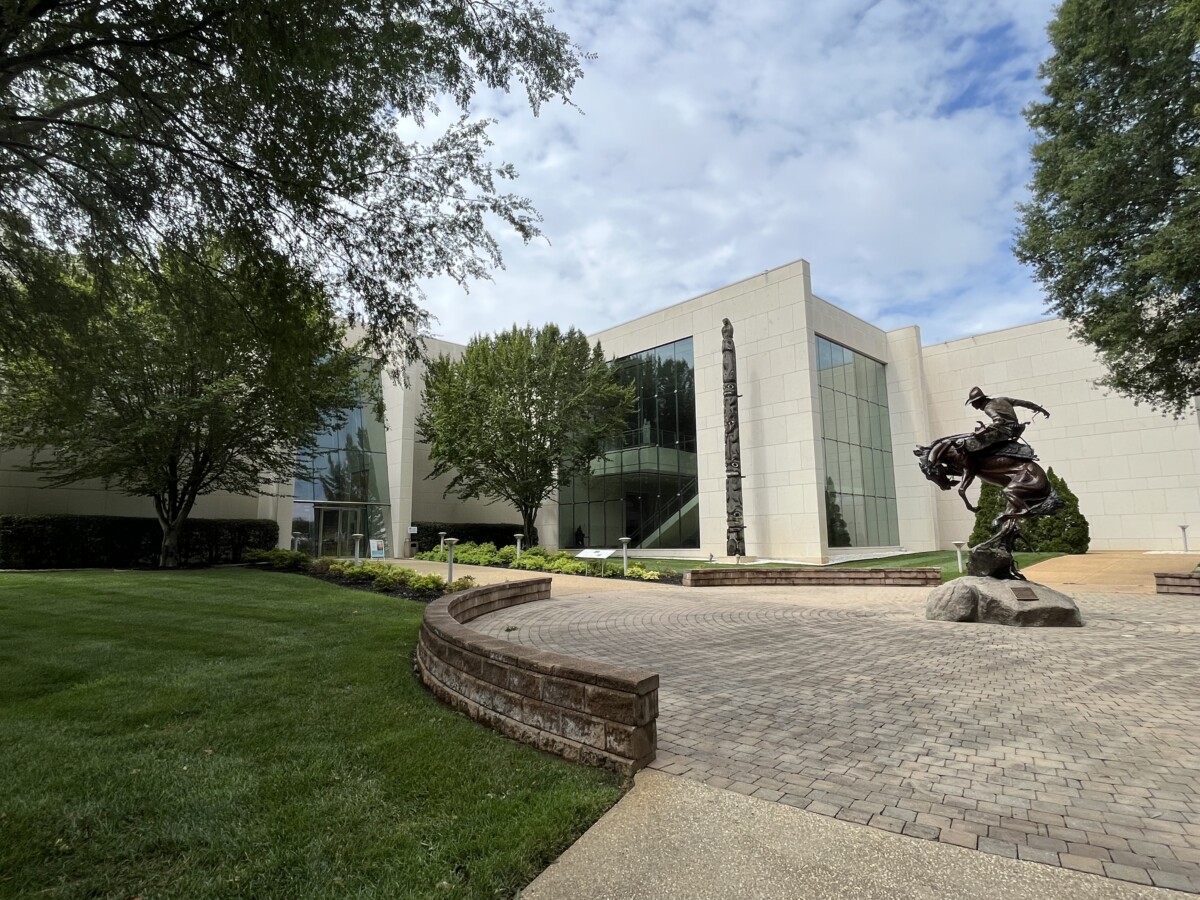For years, we’ve heard about the Booth Western Art Museum, but only recently made a visit. Wow – it is impressive!
And I’m not necessarily a fan of Western art. I tend to favor the impressionists such as Monet, Renoir, Pissarro, and Sisley. However, the paintings, sculptures, and movie posters drew me in. Who knew that Cartersville, just 45 minutes northwest of Atlanta, boasted such a great museum in this specific art genre?
History of Booth Western Art Museum
The idea for a museum began in 2000 when a local family, preferring anonymity, wanted to share their collection of Western art. By 2003, they built an 80,000-square-foot building in Cartersville and named it after their friend and mentor Samuel Booth (1920-2007) of Atlanta. The museum allows visitors to “See America’s Story” through the exhibits.

After becoming a Smithsonian Museum Affiliate in 2006, the Booth Museum expanded to 120,000 square feet in 2009. Winner of USA Today’s Best Art Museum for 2020, 2021, and 2022 (no small feat considering the US boasts over 35,000 museums), Booth is the largest museum of Western art in the country.
Galleries
A docent gave a tour of the sculptures to a group in the courtyard as we entered the limestone building designed to mimic a modern-day pueblo. Inside the two-story, light-filled foyer with a glass elevator, we learned admission includes a complimentary 45-minute tour of the sculptures at 11:15 am (we had just missed it) and a 60-90 minute museum highlights tour at 1:30 pm every day. The staff suggested starting in the American West Gallery and proceeding in the glass elevator to the second floor before catching the afternoon tour.
American West Gallery
The five-room gallery showcased paintings and sculptures evoking the early days of the Westward Expansion Movement. People on the East Coast had no idea what the frontier lands looked like. Cameras didn’t exist so artist renderings were crucial to convey the landscape, people, animals, and stories of the West.
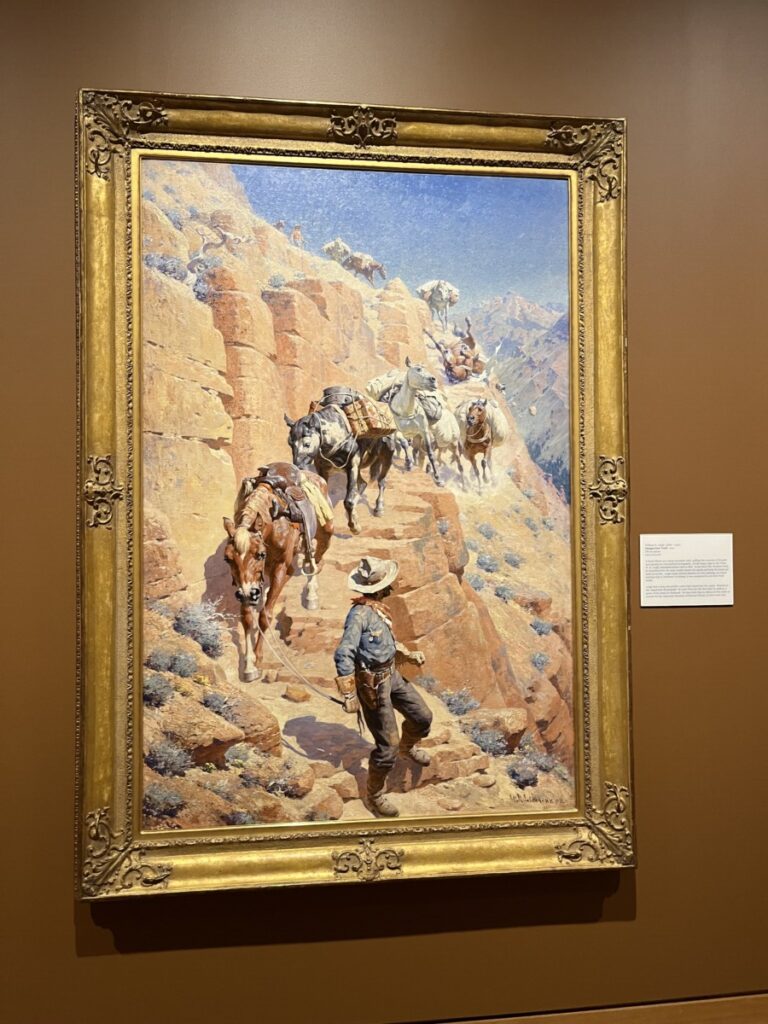
Paintings featured Native American Indians in full headdresses, the rocky terrain and cliffs of the trails, and struggles along the journey. One of my favorite paintings is “Dangerous Trail” by W.R. Leigh which depicts a horse losing his footing on a path.
In one room, a Red Bird stagecoach stood in the center amidst paintings including Fred Fellows’ “Red Bird” with Jim Dunham driving the coach. I heard Jim Dunham, Director of Special Projects at Booth, give a talk several years ago highlighting his Hollywood years as a gunslinging stunt double.
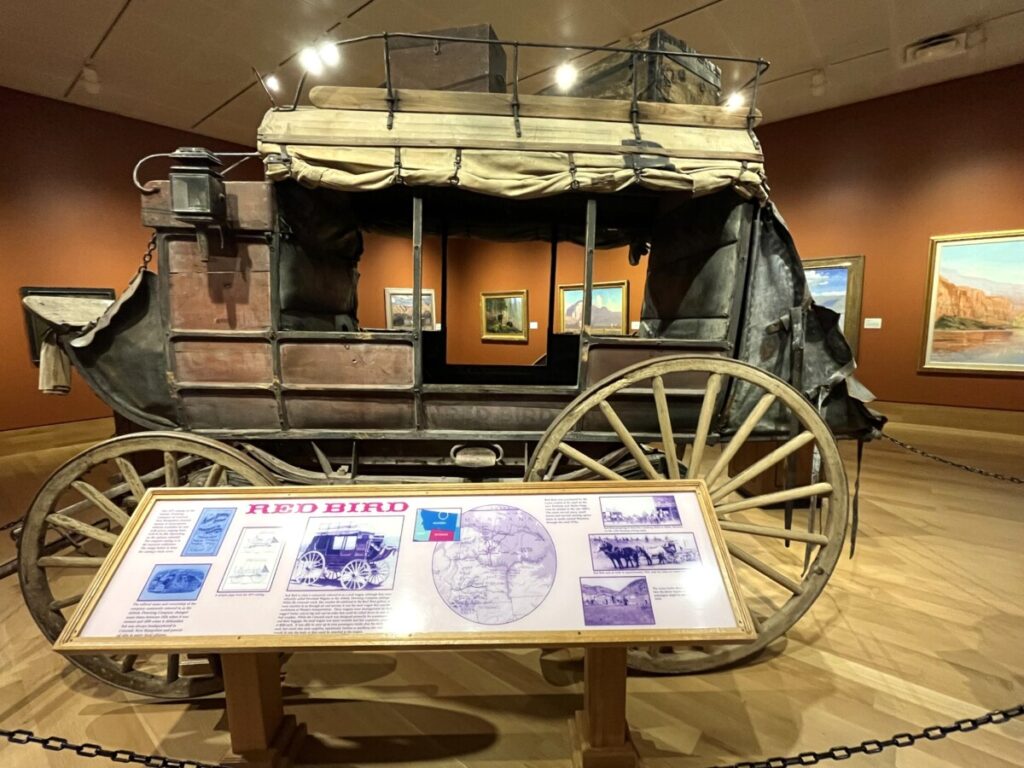
Other artists featured in these rooms were Martin Grelle, Roy Anderson, Charles Marion Russell, G. Harvey, and more. I had only heard of Charles Marion Russell, but have since researched a few of these western greats, many current members of Cowboy Artists of America.
Cowboy Gallery and Heading West Gallery
That leads us to the upper level where we entered the Cowboy Gallery. I always think of the romanticized cowboy, i.e. the Marlboro Man, but cowboys faced treacherous conditions and hard work. Paintings and sculptures by multi-talented Harry Jackson (1924-2011) were scattered throughout the museum and I particularly liked the two versions of “Ropin’ a Star” – one cast in bronze, the other hand-painted.

The Heading West Gallery depicted the harsh travel conditions of pioneers via horseback and covered wagons. Concord Stagecoach #84 sat in the middle of the room. Once again, I realized how brave travelers had to be back then.
Presidential Gallery and Commander-in-Chief Gallery
In the Miller Presidential Gallery, we took a break from Western art. Pictures of every US president with a sample of a letter each had written filled the room. I thought I had bad handwriting until I saw some of our great leaders’ penmanship!
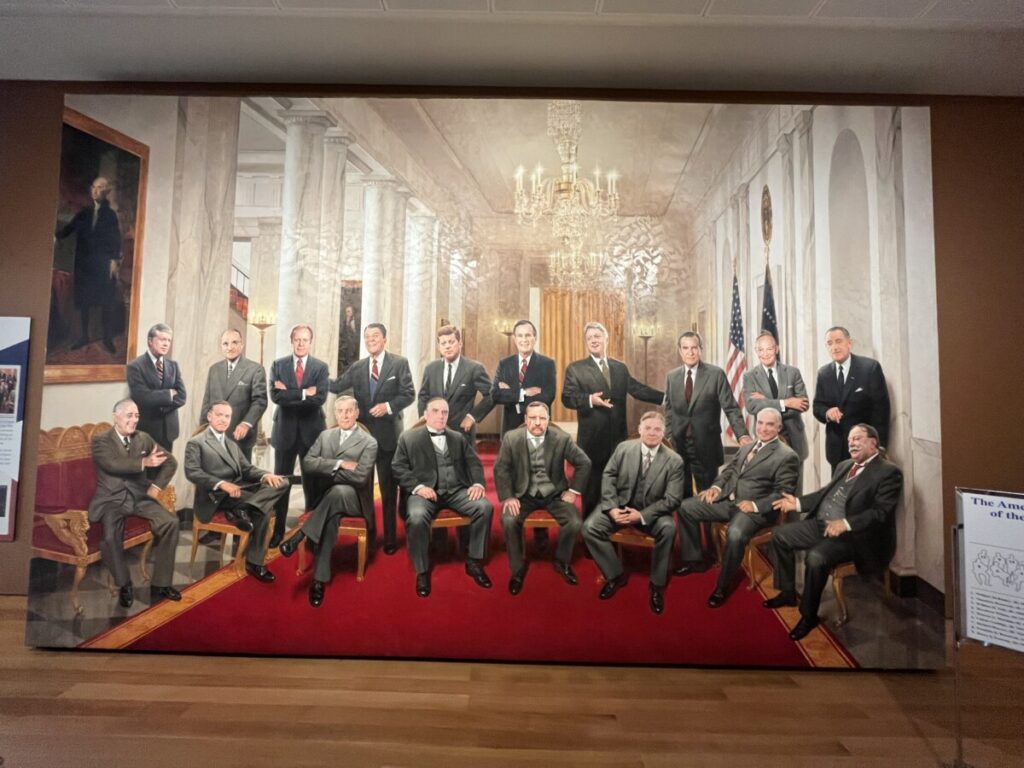
The Commander in Chief Gallery featured three large (13 x 62 feet) oil paintings by Bulgarian-born Ross R. Rossin. The first painting details all the US Presidents of the 18th and 19th centuries (George Washington through Grover Cleveland) gathered together. The second painting, just completed in 2020, shows presidents of the 20th century (William McKinley through Bill Clinton) in a similar manner. On the far wall, four figures (Bush, Obama, Trump, and Biden) stand in front of a desk ready to be accompanied by future elected presidents of the 21st century.
Special Exhibits
Taking a quick break, we watched the 15-minute orientation movie. While the orientation film isn’t necessary, I did enjoy seeing some of the art pieces in the film I had already noticed and admired.

Deciding to skip the tour at 1:30, we walked through the special exhibits including “We Set Our Faces Westward: One Woman’s Journey 1839-1848” where Heide Presse depicts scenes from the actual journal entries of pioneer Keturah Belknap. Other exhibits running at the museum were “Many Metals, Many Fires” with works by three metal workers, and “Barbara Van Cleve, Women of the West” a series of black and white photographs taken of female ranch hands during a 28-year period.
Modern West Gallery
The Modern West Gallery, located in the wing added in 2009, exhibits all types of modern works including sculptures, paintings, and other mixed media. A series of three large (7 by 4 feet) hand-painted ties by artist William Matthews grabbed my interest, as well as the tongue-in-cheek painting by Anne Coe with farm animals sharing space with a swimming pool and golf course.
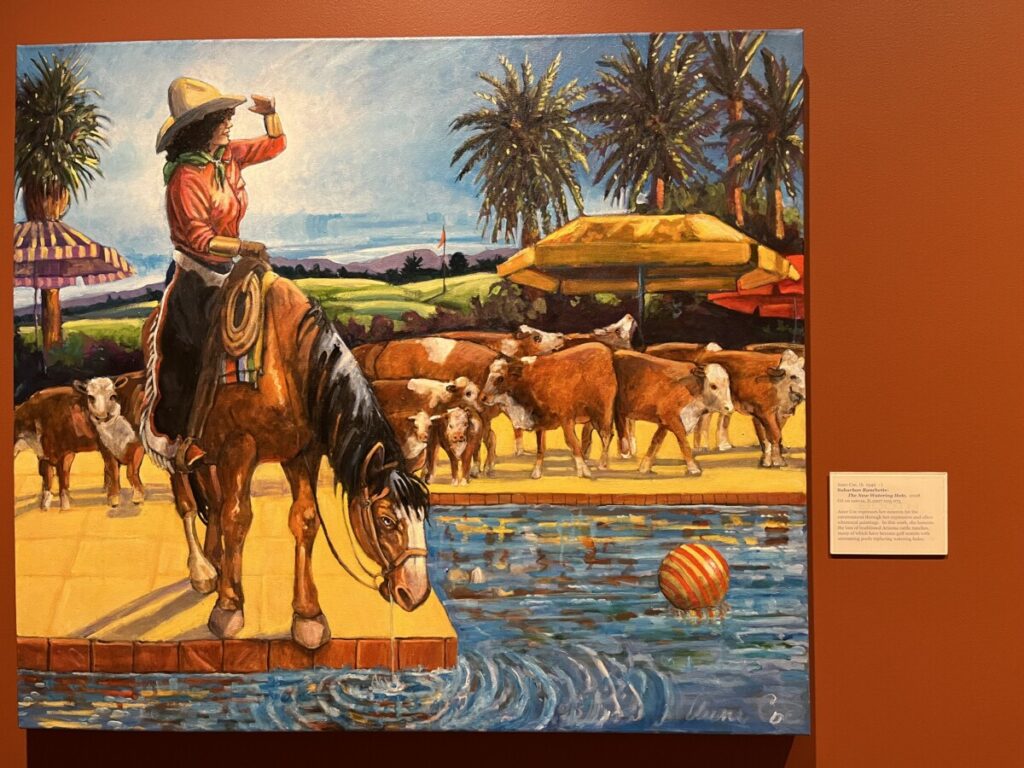
The gallery offers less rigid artwork including “Cowpony” by Lori Musil where painted cows cover a fiberglass horse. Although one horse is cleverly painted among the cows, I couldn’t find it.
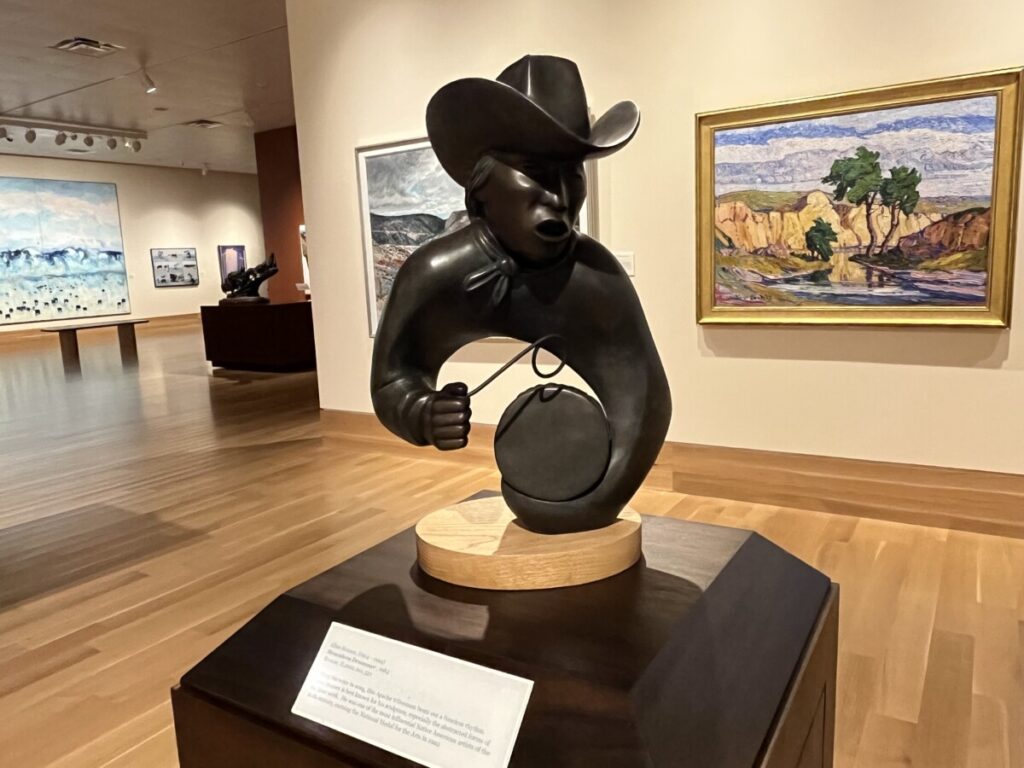
I loved the looseness of “Mescalero Drummer” by prominent Apache Indian artist Allan Capron Houser. Also, Patti and Allen Eckman’s “Prairie Edge Powwow” also impresses visitors. Made completely out of paper, the white sculpture intricately details a Native American Indian celebration. The Eckman’s taught a paper casting workshop at the museum last year.
Eaton Sculpture Atrium
We made our way downstairs via the Eaton Scultpure Atrium. By this time, we were getting worn out as we’d been at the museum over three hours. We only had one gallery left to visit.
War is Hell Gallery
Another deviation from Western art, the museum’s War is Hell Gallery displays art and sculptures illustrating the Civil War. Starting at the beginning of the war chronologically through Lee’s surrender at Appomattox, visitors get an often gruesome view of life during this time.

The painting “War is Hell” by Mort Kunstler resembles the scene in “Gone With the Wind” when Gen. Sherman marches through the burned-out city of Atlanta during his March to the Sea campaign.
Food, Fees, and More Information
The hallway to Blevins Bistro presents movie posters from Westerns in the 20th century. We ordered sandwiches and sat at a table among more movie posters. While not shaded, patio seating gave views of the outdoor sculptures.
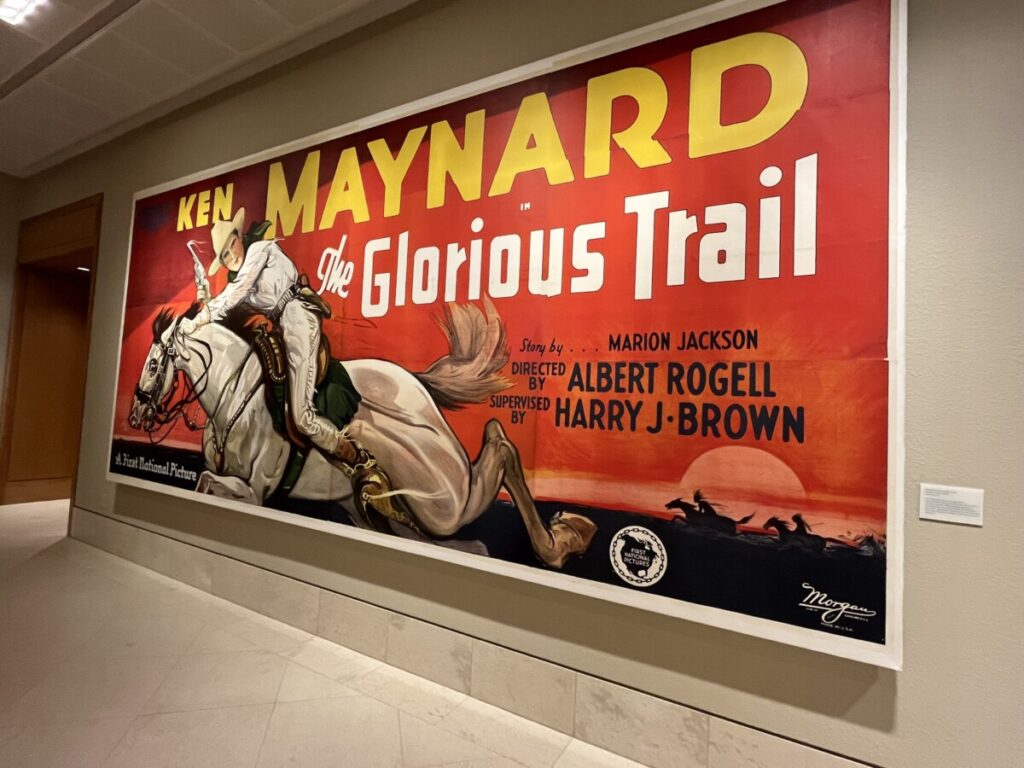
Fees to enter the museum are affordable. Additionally, the museum offers discounts for students, senior citizens, and dependents of active military. student discount and a senior citizen discount. Children age 12 and under, as well as active military, get in free of charge. Visitors also find plenty of free parking in the lot across the street.
The museum isn’t just for adults. Little ones enjoy the interactive Sagebrush Ranch on the lower level where they can dress up in cowboy clothes and pretend to ride a horse. West Fest, the museum’s annual family-friendly event, offers a full day of live music, rodeo shows, hayrides, and children’s art activities.
For more information about Booth Western Art Museum, click the website here. To learn about Cartersville’s other exciting museums, read my posts on Tellus Science Museum and Savoy Auto Museum.
